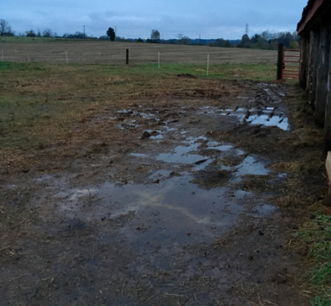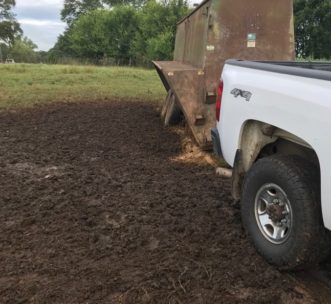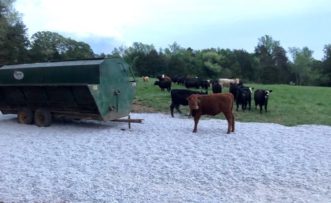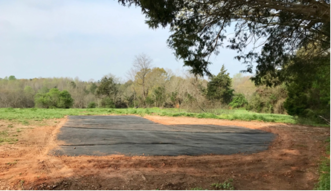Mud is a universal issue among all species of livestock, and South Carolina’s mild winters and heavy rainfall contribute to its abundance. While mud is not unique to winter, it is usually a greater concern during periods of heavy feeding. This article discusses the challenges of mud as it relates to animal health and nutrition, as well as issues with pasture and soil damage. Unfortunately, there is no “silver bullet” solution to managing mud; however, there is a systems approach requiring many small changes to your operation and feeding practices. Some of these recommendations can (and should be) implemented immediately, however many require dry weather and time to get satisfactory results.
Besides being a nuisance, muddy conditions can make daily farm chores dangerous and less efficient. While this is stressful for the producer, there is a greater effect on the animal’s health and nutrition status. Animals use more energy standing and moving across soft muddy ground than hardened or dry surfaces. The increased difficulty of traveling through the mud for feed and water has a compounding effect by decreasing intake and increasing energy requirements, which can decrease animal performance up to 25%.1 This can affect the profitability of production animals such as cattle. The Alberta Feedlot Management guide reports cattle standing in four to eight inches of mud can experience an 8% to 15% decrease in feed intake and a 14% decrease in daily gains. In hock-deep mud of twelve to twenty-four inches, expect a reduction of 30% in feed intake and a 25% decrease in daily gains. Muddy conditions also reduce the animal’s ability to maintain critical body temperature.2 Mud-caked coats reduce insulation and thereby increase energy demands to maintain core body temperatures, which have negative effects both in summer and winter. These environmental stressors can decrease the animal’s immune response and predispose it to infections such as foot rot.3 Additionally, muddy conditions can lead to abscesses, poor udder hygiene, increased calf sickness, and calving problems.4 For equine, slick conditions can increase the risk of injury. Fortunately, there are many practices to help mitigate these effects.
Solutions for Animal Challenges
Congregation and high traffic areas around gates, feeding, or watering areas are the most difficult areas to keep free of mud. These heavy-use areas are often over-grazed, exposing bare ground that is further devastated by hoof traffic and feeding machinery (figure 1). Furthermore, the standing pressure of cattle and horses, at 27 pounds per square inch (psi), is twice that of a human at 14 psi, whereas tractors place 175 psi on the soil.5 Many South Carolina soils can withstand pressures up to 28 psi when dry but will quickly weaken when wet. Simply adding loose gravel or sand can double the soil carrying capacity, and adding compacted gravel and sand can nearly triple it (figure 2). Concrete is the premier hardened surface with a carrying capacity of 6,000 psi for a 6-inch reinforced slab. Although it is the most expensive to install, the low maintenance requirements of concrete make it the more affordable long-term option. The Environmental Quality Incentives Program (EQIP), one of the flagship programs of the Natural Resources Conservation Service (NRCS), is the cost-share program that provides assistance for installing practices that help improve mud control in heavy use areas. NRCS specifications call for an initial layer of geotextile fabric which keeps the rock separate from the soil and extends the life of the pad (figure 3).5
When gravel areas fail, it is commonly from the build-up of organic matter such as manure and hay. Therefore, all improved surfaces require regular maintenance either by the removal of organic matter or re-application of gravel. While the installation of a hardened surface is not always feasible during a wet season, take note of the problem areas, and develop a plan. A change in feeding strategy can often occur in the wet season. The first step is to reduce trips in the pasture with machinery and next to control grazing pressure. Often control of grazing pressure is accomplished by using sacrifice areas and practices such as fenceline feeding. Both are more successful when combined with an improved surface, but they still provide some relief without the improved surface. A frequent contributor to a muddy pasture is the repeated driving of heavy equipment across pastures to feeding areas. While there is merit in encouraging grazing distribution through feed placement, this is better done in dry, firm conditions. Unrolling large round bales is a practice that helps distribute nutrients and feeding pressure across an area larger than a hay ring. However, this practice wastes some hay and is not ideal in extremely wet situations. Consider using a single temporary wire to reduce hay trampling with bale unrolling. A better option is a simple fenceline feeding system with an incorporated all-weather surface. Fenceline feeding over an all-weather surface saves time, improves livestock safety, reduces soil compaction and erosion, and limits runoff.6 Consider using any hardened surface for feeding, such as an abandoned roadbed or silage bunk. If hardened surfaces are not available, mitigate problem areas using alternative feeding strategies, limiting trips into the pasture, and by developing a plan to install a hardened surface when weather permits.
Pasture Damage Mitigation
In addition to densely populated feeding areas, pastures can also quickly deteriorate into muddy unproductive messes. Allowing livestock to graze wet pastures can crush and bruise plants while damaging soil structure. Treading damage from grazing livestock exposes bare soil, increases compaction, and reduces soil infiltration rates.7 Compaction in the soil further reduces plant and root growth, the water-holding capacity of the soil, and infiltration rates compounding the poor drainage issues in the pasture. Bare soil also increases the risk of erosion and nutrient run-off.8
Research in New Zealand documented a 50% to 64% reduction in spring pasture productivity following wet winter treading damage.8,9 However, removing animals from pasture completely during a wet season is not feasible either, and strategies to reduce the damage and encourage quicker recovery should be the goal. The first strategy is to avoid overgrazing pastures. A healthy stand of grass is the best defense against mud. Deep root systems characteristic of healthy forage stands create channels for water to soak into the soil more rapidly. Maintain a healthy forage stand during a wet season by using a well-constructed sacrifice lot or a sacrifice pasture.
A sacrifice pasture is one that is knowingly damaged by using it to contain all livestock and feed stored or other sources of emergency forage to save the remaining pastureland. By pulling livestock off healthy pastures and feeding hay in a sacrifice pasture during and immediately following rain events, treading and plant damage can be minimized. The healthy plants can then be left to absorb water and funnel excess moisture faster into the soil, lessening the opportunity for damage once livestock return.

Figure 4. Mud caused by barn roof runoff in an equine heavy use area. Image credit: Chris LeMaster, Clemson Extension.
The location selected for a sacrifice area is important, as the convenience of feeding, watering, and proximity to a barn or farm operations will impact its usefulness. If placed beside a barn, consideration should be given to gutter systems, ditches, or french drains to ensure water from the barn roof is adequately drained away from the lot10; so a muddy area is not caused by roof runoff (figure 4). To mitigate this, install a french drain along the barn roof drip line to drain water away from the barn (figures 5 and 6). Locate sacrifice lots or pastures on higher ground with naturally well-drained or graded slopes (2% to 4%) away from bodies of water such as streams and ponds to prevent runoff pollution.11 Further prevention measures would include buffer zones of un-grazed vegetation or other plantings, such as evergreens, to help filter excess watershed. Another pasture system design making use of a sacrifice lot would create a rotation layout, where the lot serves as a centralized hub, and where water and shelter are then located. This design works especially well for smaller livestock and horses, reducing mud in heavily traversed areas. All sacrifice systems must be managed and cleaned out regularly, as decomposing organic matter from manure, feed, and hay waste will create muddy conditions even on top of well-draining materials such as gravel.
Well-constructed sacrifice lots with incorporated all-weather surfaces can serve as feeding areas and save pastures from damage that typically occurs around hay rings and water sources. Adequate space within the sacrifice lots is important. Cow-calf pairs should have 500 to 800 square feet and 28 to 36 inches of bunk space for mature cows.12 Horse drylot areas should be 900 to 1,500 square feet per horse depending on age, size, and temperament.10 Despite the focus of this publication on mud prevention, sacrifice areas should be used as a pasture management tool any time of the year weather conditions are not favorable for forage growth, including drought. Permanently installed sacrifice lots may not be necessary for every producer and depend widely on management, stocking density, and soil type, among other variables.
The economic, nutrition, agronomic, and welfare implications of muddy conditions make mud much more serious than a nuisance. Livestock managers are afforded many options to combat mud. Often the capital improvements require drier weather; however, the use of a sacrifice area and good grazing management can be implemented immediately. Although mud is most prevalent in winter, prevention must be considered throughout the year.
References Cited
- Engstrom DF. Alberta feedlot management guide. Alberta (CA): Alberta Agriculture, Food and Rural Development; 1996.
- Garcia A. Mud reduces beef cow performance. Brookings (SD): South Dakota State University Extension; 2020. https://extension.sdstate.edu/mud-reduces-beef-cow-performance.
- Stokka GL, Lechtenberg K, Edwards T, MacGregor S, Voss K, Griffin D, Grotelueschen DM, Smith RA, Perino LJ. Lameness in feedlot cattle. Veterinary Clinics of North America: Food Animal Practice. 2001 Jan [accessed 2020 April 16];17(1):189–207. https://www.sciencedirect.com/science/article/abs/pii/S0749072015300621.
- Halfman W. Muddy conditions influence on beef cattle performance. Madison (WI): University of Wisconsin Cooperative Extension; 2016 Apr. https://fyi.extension.wisc.edu/wbic/2016/04/01/muddy-conditions-influence-on-beef-cattle-performance/.
- Higgins S, Melhope S, Moser L, Wightman S. All-weather surfaces for livestock. Lexington (KY): University of Kentucky Cooperative Extension Service; 2017. AEN-115. http://www2.ca.uky.edu/agcomm/pubs/aen/aen115/aen115.pdf
- Higgins S, Moser L. Fenceline feeder systems for beef cattle production and resource conservation. Lexington (KY): University of Kentucky Cooperative Extension Service; 2019. AEN134. http://www2.ca.uky.edu/agcomm/pubs/AEN/AEN134/AEN134.pdf.
- Pande TN, Valentine I, Betteridge K, Mackay A, Horne D. Pasture damage and regrowth from cattle treading. Proceedings of the Conference – New Zealand Grassland Association; 2000. NZ Grassland Association: 2000 [accessed 2020 April 16]. 62:155–160. https://www.researchgate.net/profile/Keith_Betteridge/publication/267801412_Pasture_damage_and_regrowth_from_cattle_treading/links/54ecfcb50cf27fbfd771e314.pdf.
- Whitmore A. Impact of livestock on soil. Landbauforschung Volkenrode FAL Agricultural Research, Sonderheft. 2001 [accessed 2020 April 16]; 226:39-41. https://literatur.thuenen.de/digbib_extern/zi025653.pdf#page=46.
- Brown KR, Evans PS. Animal treading: A review of the work of the late DB Edmond. New Zealand Journal of Experimental Agriculture. 1973 Sep [accessed 2020 April 16]; 1(3):217–226. https://www.tandfonline.com/doi/abs/10.1080/03015521.1973.10427646.
- Higgins S, Dwyer R. Using dry lots to conserve pastures and reduce pollution potential. Lexington (KY); University of Kentucky College of Agriculture Cooperative Extension Service; 2008. Id-171. http://www2.ca.uky.edu/agcomm/pubs/id/id171/id171.pdf
- Nadeau J. Pasture: planning, seeding and sacrifice areas. Mansfield (CT): University of Connecticut Department of Animal Science Extension Articles; 2006. https://opencommons.uconn.edu/ansc_ext/7/?utm_source=opencommons.uconn.edu%2Fansc_ext%2F7&utm_medium=PDF&utm_campaign=PDFCoverPages
- Rasby R. Confinement feeding beef cows. 42nd Annual Cornbelt Cow-Calf Conference; 2013 Jan; Ottumwa (IA). Ames (IA): Iowa State University Extension and Outreach, Iowa Beef Center; 2013. http://www.iowabeefcenter.org/proceedings/ConfinementFeedingBeefCows.pdf.






